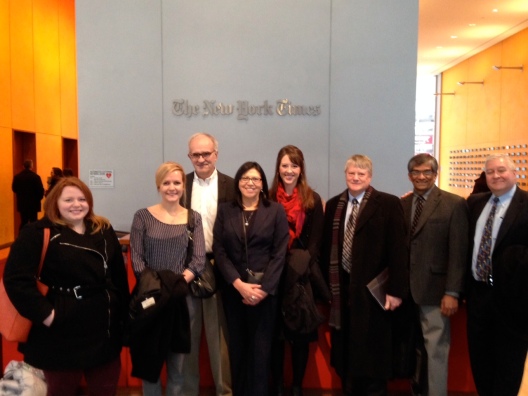
- A silhouette of Arthur Suzberger Jr., publisher of The New York Times and chairman of The New York Times Company, against a window framing a Manhattan skyline. Sulzberger hosted a lunch on Jan. 22 at The New York Times for the Wisconsin Center for Investigative Journalism to talk about the future of investigative journalism. In addition to Sulzberger, also present at the meeting were: Matt Purdy, deputy executive editor at The New York Times, Walt Bogdanich, NYT investigative reporter/editor and an alumnus of the University of Wisconsin-Madison School of Journalism and Mass Communication; Sarah Cohen, editor of NYT computer-assisted reporting team and board president of Investigative Reporters and Editors; Robert Gebeloff, NYT data journalism specialist and a UW-Madison SJMC alumnus; Gloria Anderson, UW-Madison SJMC alumnus and former vice president for International and Editorial Development at NYT News Services Division; Brant Houston, WCIJ board president and the John S. and James L. Knight Foundation Chair in Investigative and Enterprise Reporting at the University of Illinois at Urbana-Champaign; Hemant Shah, WCIJ board member and director of the University of Wisconsin-Madison SJMC; Andy Hall, WCIJ founder and executive director; Lauren Fuhrmann, WCIJ associate director; Sara Jerving, former WCIJ intern and an environmental investigative reporting fellow at Columbia University Graduate School of Journalism; Alexandra Tempus, former WCIJ intern and a writer in New York; and me, Karen Lincoln Michel, WCIJ board vice president.
It took a trip to New York last week to finally hear fellow journalists validate something I believe is true: The quality and quantity of investigative journalism are on the rise.

The Jan. 22 lunch was held at The New York Times building. Before the meeting, NYT publisher Arthur Sulzberger Jr. gave his guests a tour. Pictured here in the NYT board room, from left to right, are Andy Hall, Gloria Anderson, Alexandra Tempus, Sara Jerving, Hemant Shah, Lauren Fuhrmann, Arthur Sulzberger Jr. and Brant Houston.
A dozen investigative editors, investigative reporters, journalists and educators on Jan. 22 gathered over lunch, hosted by The New York Times Publisher Arthur Sulzberger Jr., to talk about the future of investigative journalism and the important role collaboration plays in it.
For small and regional markets, collaboration is key.
What I heard at this intimate gathering was that although the size of newsroom staffs across the country has dwindled in recent years, some news organizations, including The New York Times, have put precious resources into building investigative teams. Some companies also combine resources among their regional properties to do so. And with the growth of nonprofit, nonpartisan news organizations – such as the Wisconsin Center for Investigative Journalism – there are more opportunities for news outlets to enhance their watchdog coverage.
As WCIJ vice president, I have seen the difference that a statewide, nonprofit investigative journalism center can make.
Since its launch in 2009, WCIJ has produced more than 165 major news reports and 165 Money & Politics columns. These reports and columns have been cited, published or broadcast by more than 230 newspapers, radio and TV stations and news websites in Wisconsin and across the nation. The estimated audience of the center’s reports is more than 35 million people.
WCIJ has created a model for collaborative local investigative journalism that has been replicated in other states. In addition, the center has authored industry guidebooks and advised other nonprofit investigative news organizations on ethics, fact checking, collaboration, financial transparency, fiscal sponsorship and business practices. WCIJ also serves as a training ground for current and future journalists through workshops, classroom collaborations and paid internships.

Walt Bogdanich, investigative editor and reporter at The New York Times, visits with WCIJ guests after a forward-looking conversation on investigative journalism.
At The New York Times, an investigative reporting team focuses on in-depth stories while a computer-assisted reporting team collaborates with reporters and editors on how best to tell these kinds of stories visually.
Matt Purdy, deputy executive editor at The New York Times, said the Times’ investigative team has grown since it started under former executive editor Bill Keller, and that the paper is committed to pursuing hard-hitting, investigative stories.
As an example, Purdy mentioned a piece that his newspaper published two days earlier about a U.S. research lab in Nebraska that uses surgery and breeding techniques on animals to benefit the meat industry, but at huge risks to the animals. He said it took about a year to research, report, write, edit and publish the story.
Granted, most news organizations lack the resources to devote that much time and staff to one story. Only large metro papers and national news outlets have the luxury to publish such pieces on their own.
That’s why nonprofit journalism is so important, and why the future of investigative journalism depends on it.
The best indication of that future could be seen in the two former interns who sat at the table that day. They spoke of the value of their internships with WCIJ, and how it prepared them for real-world journalism like no other singular experience.
Although the public might perceive investigative journalism on the downswing – amid all the chatter and non-news sites that provide information online – the state of investigative journalism is strong.

Left to right: Alexandra Tempus, Sara Jerving, Walt Bogdanich, Karen Lincoln Michel, Lauren Fuhrmann, Brant Houston, Hemant Shah and Andy Hall.
Follow me on Twitter @karenmichel.